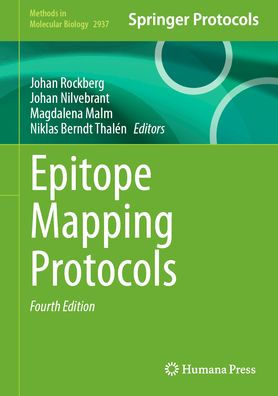Epitope Mapping Protocols
This detailed new edition explores methodologies for the characterization of antibody-antigen interactions tailored to different applications and requirements. Beginning with an overview of key concepts and definitions related to antibody epitopes, the book continues with sections on structural biology methods, display technologies to analyze libraries of proteins or protein arrays, techniques based on protein labeling, as well as computational approaches and binding assays that rely on binding interactions or competition. Written for the highly successful Methods in Molecular Biology series, chapters include introductions to their respective topics, lists of the necessary materials and reagents, step-by-step and readily reproducible laboratory prools, and tips on troubleshooting and avoiding known pitfalls.
1127928790
Authoritative and up-to-date, Epitope Mapping Prools, Fourth Edition serves as an ideal resource for scientists from a wide range of fields involved in critical antibody research.
Chapter 19 is available open access under a Creative Commons Attribution 4.0 International License via link.springer.com.
Epitope Mapping Protocols
This detailed new edition explores methodologies for the characterization of antibody-antigen interactions tailored to different applications and requirements. Beginning with an overview of key concepts and definitions related to antibody epitopes, the book continues with sections on structural biology methods, display technologies to analyze libraries of proteins or protein arrays, techniques based on protein labeling, as well as computational approaches and binding assays that rely on binding interactions or competition. Written for the highly successful Methods in Molecular Biology series, chapters include introductions to their respective topics, lists of the necessary materials and reagents, step-by-step and readily reproducible laboratory prools, and tips on troubleshooting and avoiding known pitfalls.
Authoritative and up-to-date, Epitope Mapping Prools, Fourth Edition serves as an ideal resource for scientists from a wide range of fields involved in critical antibody research.
Chapter 19 is available open access under a Creative Commons Attribution 4.0 International License via link.springer.com.
164.99
Pre Order
5
1

Epitope Mapping Protocols
394
Epitope Mapping Protocols
394Hardcover(Fourth Edition 2025)
$164.99
164.99
Pre Order

Product Details
| ISBN-13: | 9781071645901 |
|---|---|
| Publisher: | Springer US |
| Publication date: | 07/24/2025 |
| Series: | Methods in Molecular Biology , #2937 |
| Edition description: | Fourth Edition 2025 |
| Pages: | 394 |
| Product dimensions: | 7.01(w) x 10.00(h) x (d) |
From the B&N Reads Blog
